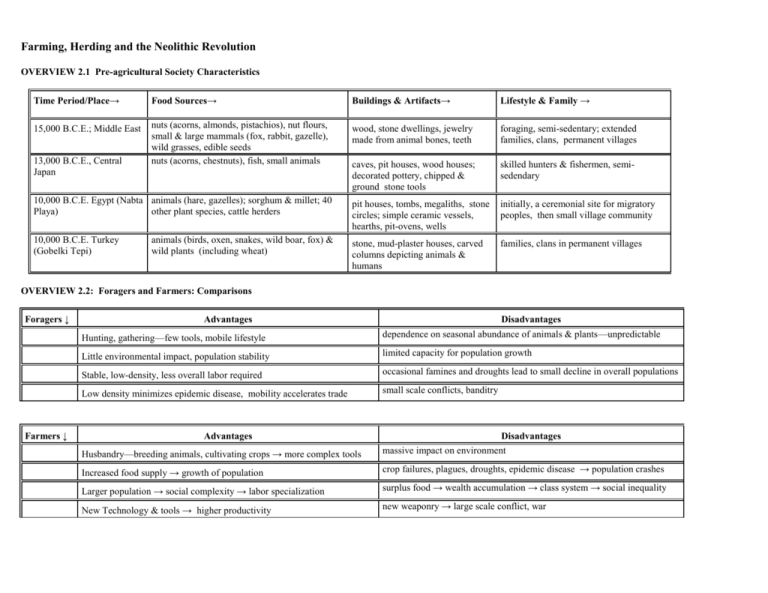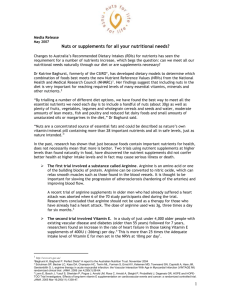Chapter 1: Out of the Ice: The Peopling of the Earth
advertisement

Farming, Herding and the Neolithic Revolution OVERVIEW 2.1 Pre-agricultural Society Characteristics Time Period/Place→ Food Sources→ Buildings & Artifacts→ Lifestyle & Family → 15,000 B.C.E.; Middle East nuts (acorns, almonds, pistachios), nut flours, small & large mammals (fox, rabbit, gazelle), wild grasses, edible seeds nuts (acorns, chestnuts), fish, small animals wood, stone dwellings, jewelry made from animal bones, teeth foraging, semi-sedentary; extended families, clans, permanent villages caves, pit houses, wood houses; decorated pottery, chipped & ground stone tools skilled hunters & fishermen, semisedendary 10,000 B.C.E. Egypt (Nabta animals (hare, gazelles); sorghum & millet; 40 Playa) other plant species, cattle herders pit houses, tombs, megaliths, stone circles; simple ceramic vessels, hearths, pit-ovens, wells initially, a ceremonial site for migratory peoples, then small village community 10,000 B.C.E. Turkey (Gobelki Tepi) stone, mud-plaster houses, carved columns depicting animals & humans families, clans in permanent villages 13,000 B.C.E., Central Japan animals (birds, oxen, snakes, wild boar, fox) & wild plants (including wheat) OVERVIEW 2.2: Foragers and Farmers: Comparisons Foragers ↓ Farmers ↓ Advantages Disadvantages Hunting, gathering—few tools, mobile lifestyle dependence on seasonal abundance of animals & plants—unpredictable Little environmental impact, population stability limited capacity for population growth Stable, low-density, less overall labor required occasional famines and droughts lead to small decline in overall populations Low density minimizes epidemic disease, mobility accelerates trade small scale conflicts, banditry Advantages Disadvantages Husbandry—breeding animals, cultivating crops → more complex tools massive impact on environment Increased food supply → growth of population crop failures, plagues, droughts, epidemic disease → population crashes Larger population → social complexity → labor specialization surplus food → wealth accumulation → class system → social inequality New Technology & tools → higher productivity new weaponry → large scale conflict, war OVERVIEW 2.3: Characteristics of Herding and Agricultural Societies Type of Husbandry Environment Region Time Period Animals or Crops Herding tundra, evergreen forests; grasslands, steppe regions Scandinavia, North America, Eurasian & African grasslands 5,000 B.C.E. reindeer, seal, walrus, horses, sheep, cattle Agriculture small-scale alluvial plains Jericho on River Jordan, Catalhuyuk in Anatolia 8,000-7000 B.C.E. einkorn, wheat, pulses (peas, beans), fruits, nuts Agriculture large alluvial plains 5,000 B.C.E. grains, pulses, rice, millet, fruits, nuts Agriculture uplands Nile, Tigris, Euphrates, Indus & Yangtse River valleys Andes, Peru; Mexico; Old World (Eurasia, Africa) 12, 000-5,000 B.C.E. maize (Mexico), beans, squash (Mexico) potatoes, quinoa (Andes); tef, rye, barley (Old World) Agriculture swamps Yangtse Valley, Ganges Valley,. S.E. Asia; West Africa; Amazon 9,000-1,500 years ago rice (China, S.E. Asia, Ganges Valley); yams, oil palm dates (West Africa); bitter manioc (Amazon)











